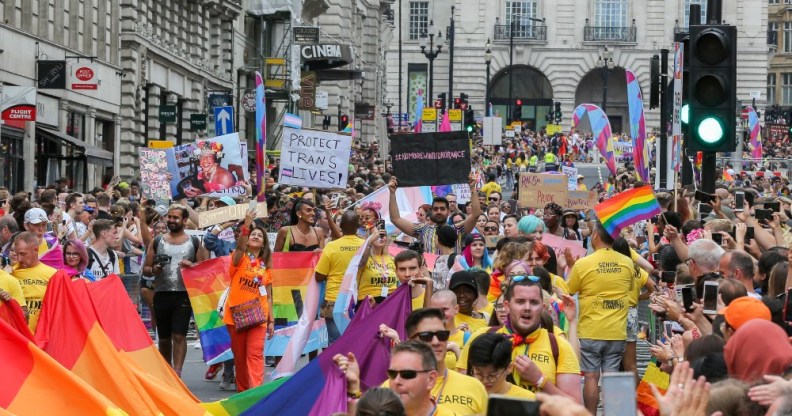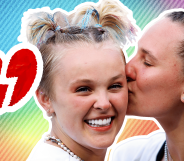More people identifying as lesbian, gay or bisexual in UK than ever before, ONS says

Huge crowds gathered for Pride in London in 2019. (Dinendra Haria/ SOPA Images/LightRocket/ Getty)
Huge crowds gathered for Pride in London in 2019. (Dinendra Haria/ SOPA Images/LightRocket/ Getty)
The number of over-65s in the UK who identify as lesbian, gay or bisexual has increased for the first time, figures released Thursday (27 May) show.
In a small but seismic bump between 2018 and 2019, the proportion of people aged 65 and over who say they are LGB leapt from 0.7 per cent to one per cent, according to the Office for National Statistics.
Despite this increase, the new analysis showed the years-long trend of the largest amount of LGB people being packed into the lower age brackets.
The analysis, based on figures from the Annual Population Survey, showed that one-third of LGB people in the UK are between 16 and 24.
Overall, the agency’s 2019 report on sexual orientation gave a snapshot of a UK where more and more feel able to live their authentic selves with more people than ever before identifying as LGB+.
More people than ever before identify as gay, lesbian or bisexual in the UK
The data, the latest in an annual series on LGB+ populations, showed that the proportion of the UK population aged 16 years and over who are straight shrank from 94.6 per cent in 2018 to 93.7 per cent in 2019.
In 2019, 2.7 per cent of the population said they were LGB, up from 2.2 per cent the previous year. This represents a thumping 200,000 people jump.
This spike was seen across almost all demographics. LGB women leapt by 0.2 per cent to 2.5 per cent, men from 2.5 per cent to 2.9 per cent.
Men were almost twice as likely as women to identify as gay, while women were more likely to be bisexual than men.
Such a figure is a triumphant broadside against the anti-trans trope that lesbians in the UK are facing so-called “extinction” because, er, trans people exist.
And in a not exactly surprising climb, there’s been yet another upswing in the number of LGB young people in the UK. Around one in 15 people aged between 16 and 24 are LGB (6.6 per cent).
Younger people (those aged 16 to 24) were most likely to identify as LGB in 2019, although there were also rises in the proportion of older people (aged 65 and over) identifying as LGB https://t.co/aX92C3WjX1 pic.twitter.com/yhuDy32FT1
— Office for National Statistics (ONS) (@ONS) May 27, 2021
Statisticians suggested that “younger people could be more likely to explore their sexuality, combined with more social acceptability of different sexual identities and the expression of these today”.
Within the ONS’ data, the “other” box, which it says captures those who are not heterosexual or LGB, has also inched upwards.
In 2018, 0.6 per cent of the population identified as something other than straight or LGB – it has since increased by 0.1 per cent.
As much as surges were seen across England and Scotland, figures for Northern Ireland and Wales remains static.
London once again remains a hub of safety and acceptance for the community in England, the data suggests, with 3.8 per cent of residents identifying as LGB.
Statisticians suggested that this might be because there are more young people living in London compared to other regions of the country.
This means that people living in the capital city are more likely to LGB than anywhere else in England, whereas those based in the east are the least likely, at 2.1 per cent.
As much as so-called “debates” over LGBT-inclusive education raged in 2019 and hate crimes rocketed, it seems that acceptance for LGB+ people has flourished.
Indeed, the boom in the number of LGB people in the UK is “significant”, said Penelope McClure, who works at the ONS’ Population Statistics Division, in the report.
“An estimated 1.4 million people aged 16 and over in the UK identified as lesbian, gay or bisexual (LGB) in 2019 – a statistically significant increase from 1.2 million in 2018 – continuing the trend we have seen over recent years,” she said.
“People aged 16 to 24 continue to be the most likely to identify as LGB, however, the proportion of older adults identifying as LGB, while much smaller, is also increasing.”

